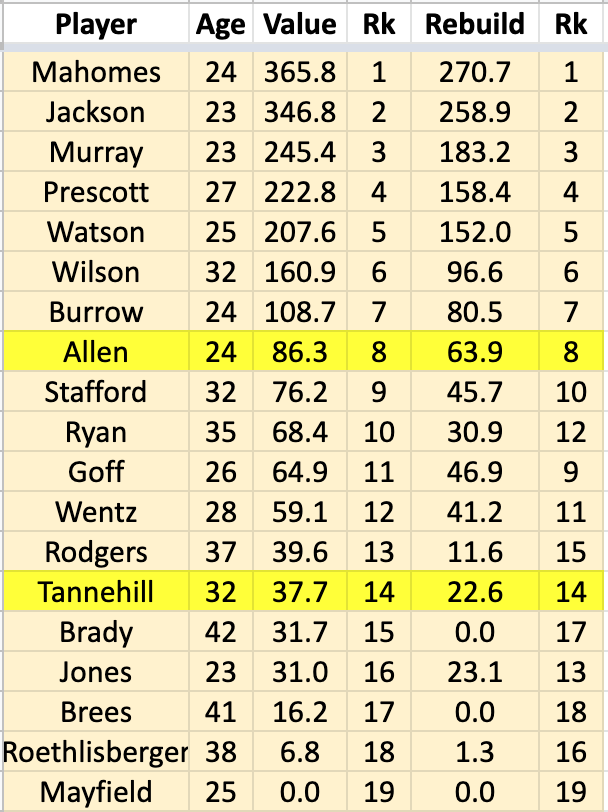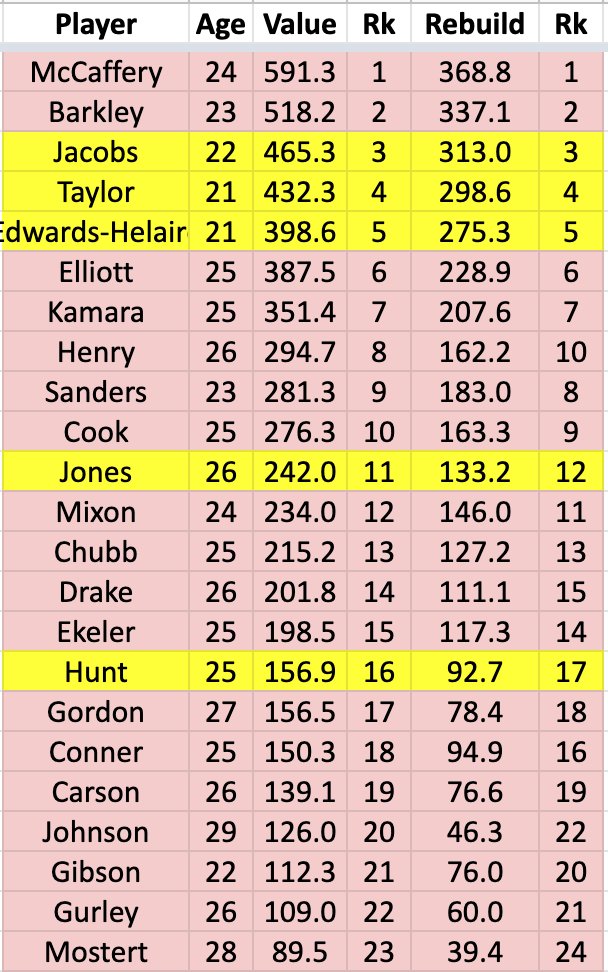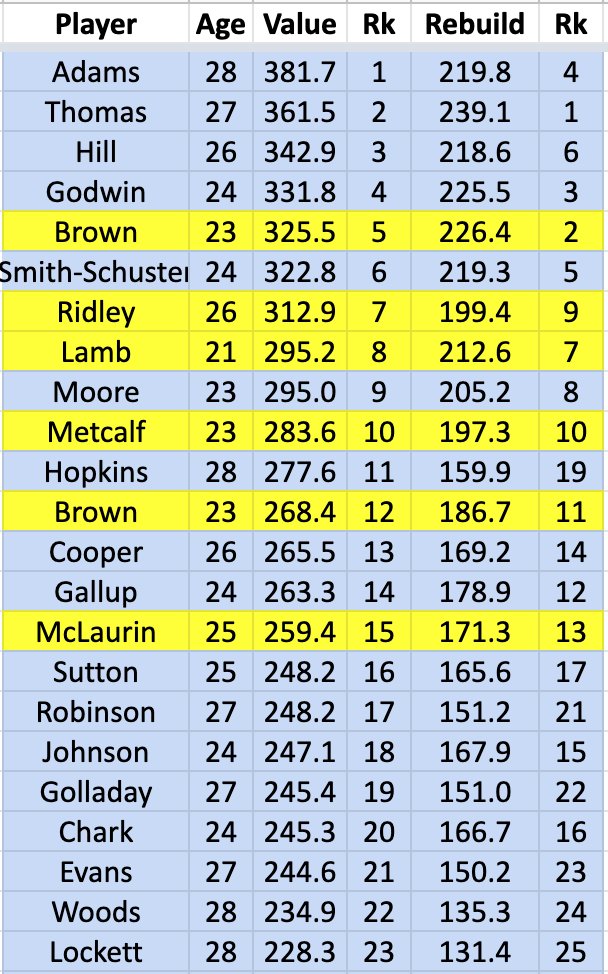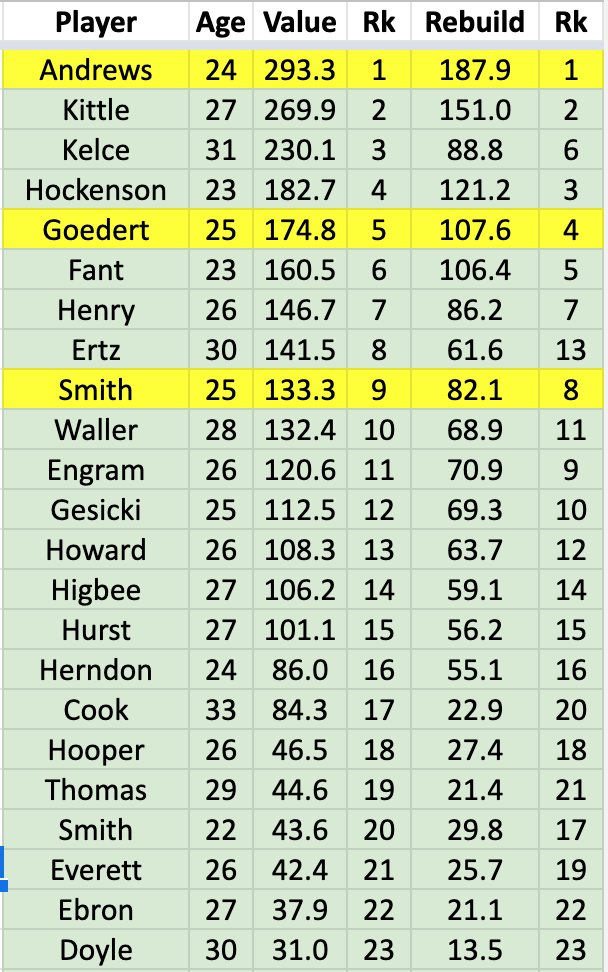So this is totally doing the "Make the case that I add value to the group of people who have already decided I add value" thing.
But I talked this morning about good processes blending systems and intuition and I wanted to get into how I do that and why my processes are good.
But I talked this morning about good processes blending systems and intuition and I wanted to get into how I do that and why my processes are good.
First example. I know from research that we think about aging the wrong way. "Age curves" model populations in the aggregate, but they *do not* model individual careers. It& #39;s ecological fallacy. More on this here: https://subscribers.footballguys.com/apps/article.php?article=HarstadMortalityTables">https://subscribers.footballguys.com/apps/arti...
Instead, players tend to maintain their value indefinitely, fluctuating up and down from a set mean essentially at random until they suddenly and catastrophically decline.
I& #39;ve modeled this based on historical decline chances to create a system for estimating years remaining.
I& #39;ve modeled this based on historical decline chances to create a system for estimating years remaining.
All of my "years remaining" estimates are available for freesies here: https://docs.google.com/spreadsheets/d/1hocVUVVLlXLt2wBfLoq-xk01QQuk7aljFf9dA3bVOi8/edit?usp=sharing">https://docs.google.com/spreadshe...
You& #39;re welcome, dynasty buddies.
You& #39;re welcome, dynasty buddies.
This is my system.
But this system allows for intuition. The model was trained on players I selected because I knew they were good. Applicability to current players depends on whether they are also good. "Years remaining" means something different for Akers than for Barkley.
But this system allows for intuition. The model was trained on players I selected because I knew they were good. Applicability to current players depends on whether they are also good. "Years remaining" means something different for Akers than for Barkley.
I can also mentally adjust.
Think Russell Wilson will play longer than expected because he avoids hits? Great. Think Lamar Jackson will play shorter because he doesn& #39;t? Great. You can do that. You can use context and intuition and "soft factors" to adjust the naive outputs.
Think Russell Wilson will play longer than expected because he avoids hits? Great. Think Lamar Jackson will play shorter because he doesn& #39;t? Great. You can do that. You can use context and intuition and "soft factors" to adjust the naive outputs.
But those naive outputs still serve as guard rails.
I had some last week telling me they thought Wilson would last longer than Lamar Jackson. It& #39;s possible! But Lamar Jackson& #39;s EYR is 11.26 and Wilson& #39;s is 4.00. No amount of "soft factors" can bridge that divide for me.
I had some last week telling me they thought Wilson would last longer than Lamar Jackson. It& #39;s possible! But Lamar Jackson& #39;s EYR is 11.26 and Wilson& #39;s is 4.00. No amount of "soft factors" can bridge that divide for me.
I make allowances for me to place my thumb on the scale, but at the end of the day my system is in place to tether me to reality and prevent me from pressing too hard.
I have a process, but within that process there& #39;s room for intuition.
I have a process, but within that process there& #39;s room for intuition.
This is just my process for modeling aging. Since players don& #39;t decline so much as fluctuate until they implode, if you know a player& #39;s "true mean" production level and aging pattern, you can just multiply them out to create fantasy values.
That& #39;s another system I use.
That& #39;s another system I use.
For this system, I use FBGs& #39; rest-of-season projections as a proxy for "true production level" for players who have finished the ascent portion of their career. That& #39;s a system.
But I also allow overrides based on context and for still-ascending players. That& #39;s intuition.
But I also allow overrides based on context and for still-ascending players. That& #39;s intuition.
(The "rest of season projections" input is also built by a system designed to allow room for intuition, but it& #39;s not *MY* system so I won& #39;t go into it too much.)
These "career value" estimates are evidence about player value. Like any good Bayesian, I use this evidence to update my priors. How much I update depends on how strong the evidence is and how strong my prior was. Updating is a system, but my priors often rely on intuition.
Even my priors are often determined by a system.
How do I value Cam Akers? Well, I don& #39;t scout, but I do believe the draft is a relatively efficient market, so my initial prior for him is that he& #39;s relatively typical of running backs taken 52nd overall in the NFL draft.
How do I value Cam Akers? Well, I don& #39;t scout, but I do believe the draft is a relatively efficient market, so my initial prior for him is that he& #39;s relatively typical of running backs taken 52nd overall in the NFL draft.
And as we get new information (he can& #39;t beat out Darrell Henderson and Malcolm Brown) I update that prior (he might not be as good as a typical 52nd pick) based on my confidence in the new information (sometimes coaches ease rookies in slowly).
Building out player values like this is a lot of work, so sometimes I use quick heuristics, or simple rules of thumb, that approximate this process.
For example: young talented players should be drafted higher in dynasty than redraft.
For example: young talented players should be drafted higher in dynasty than redraft.
(This is a heuristic, but also a system; dynasty value is often a first-order approx of age, pedigree, and last-year production, so if a young/highly-drafted player performs well he& #39;ll be valued higher after the season. Value him high now and you get that *PLUS* the production.)
But even within the heuristic, there& #39;s room for interpretation. It guides my actions, it directs my attention, but I& #39;m not necessarily a slave to its outputs. Sometimes my opinion differs.
But it doesn& #39;t differ *A TON*. The system acts as a guard rail to my intuition.
But it doesn& #39;t differ *A TON*. The system acts as a guard rail to my intuition.
I say that this is all good process. If it is, it should lead to good outcomes. Can I give some examples of my system? I can.
Before the season, I tweeted about four good/young players who were rated higher in redraft than in dynasty (or, in one case, close).
Before the season, I tweeted about four good/young players who were rated higher in redraft than in dynasty (or, in one case, close).
Player #1: Ronald Jones
"But oh, he& #39;s no good, the redraft guys are wrong" the dynasty community wailed at me. "The Leonard Fournette signing proves the dynasty guys were right!" they said.
He& #39;s basically free, I said, might as well take the gamble. https://twitter.com/AdamHarstad/status/1276266531115106304">https://twitter.com/AdamHarst...
"But oh, he& #39;s no good, the redraft guys are wrong" the dynasty community wailed at me. "The Leonard Fournette signing proves the dynasty guys were right!" they said.
He& #39;s basically free, I said, might as well take the gamble. https://twitter.com/AdamHarstad/status/1276266531115106304">https://twitter.com/AdamHarst...
Ronald Jones now leads all NFL players in rushing yardage over expectation.
I get why people hated him. I wasn& #39;t a fan of him either. But he was a 23yo former high draft pick who had improved a lot in Year 2 and who the redraft guys liked in Year 3. The system said buy.
I get why people hated him. I wasn& #39;t a fan of him either. But he was a 23yo former high draft pick who had improved a lot in Year 2 and who the redraft guys liked in Year 3. The system said buy.
Player #2: Josh Jacobs. Redrafters loved him. Dynasty community was lukewarm. He was RB6 through the bye. Dynasty market hasn& #39;t moved much yet, but if he finishes the season as a Top-5 / Top-6 guy at Age 22, it will. https://twitter.com/AdamHarstad/status/1305223316605730817">https://twitter.com/AdamHarst...
Player #3: Terry McLaurin. Same story as Jacobs. Market hasn& #39;t moved much yet. I& #39;m betting it will by season& #39;s end. Buy early, don& #39;t buy late. https://twitter.com/AdamHarstad/status/1312036473697435650">https://twitter.com/AdamHarst...
Player #4: A.J. Brown. (Searching for the tweet but having trouble finding because "Brown" is a common name. I guess just trust me that I tweeted about it in Aug/Sep?)
This was less that redrafters love him and more that Bob Henry loved him and I place extra weight on that.
This was less that redrafters love him and more that Bob Henry loved him and I place extra weight on that.
Again, some of these guys have increased in value, others haven& #39;t yet, but I think all four demonstrate that the redrafters are better at predicting short-term production than the dynasty guys. Dynasty market value is a lagging indicator. The system identifies future values.
I can& #39;t give you the naive dynasty values using FBGs& #39; current RoY projections because FBGs& #39; current RoY projections are paywalled. But I can show what they looked like after Week 1, which also highlights how a rigorous system helps identify value.
Here& #39;s totally naive dynasty values for QBs after 1 week (using just age, position, and 2020 projections as inputs).
I& #39;ve highlighted some guys who were well above dynasty market value at the time. Consider: have those guys generally increased or decreased in value since Week 1?
I& #39;ve highlighted some guys who were well above dynasty market value at the time. Consider: have those guys generally increased or decreased in value since Week 1?
Here are the naive RB values after Week 1. Again I& #39;ve highlighted some guys who stood out as "buys" at the time. Have they increased or decreased in value since then?
Here& #39;s WR. You know who had A.J. Brown, Calvin Ridley, CeeDee Lamb, and D.K. Metcalf *all* as Top-10 dynasty receivers after Week 1 this year? This guy(& #39;s system of using age-adjusted redraft expectations to create naive dynasty values)
(An example of room for intuition within the system; I felt that the Week 1 value for McLaurin was too low and personally adjusted him upwards a bit. In subsequent weeks, his 2020 projection rose and now the system has him where my intuition had him before.)
Here& #39;s Tight End. By market value, Austin Hooper was ~TE10 and Jonnu Smith was ~TE16. By age-adjusted redraft expectations, Smith was TE9 and Hooper was TE18.
My intuitions regressed both of those, but the system set limits on my intuition. Result? I traded Hooper for Smith.
My intuitions regressed both of those, but the system set limits on my intuition. Result? I traded Hooper for Smith.
Not saying the hit rate is perfect. (Obviously it& #39;s not.) But hopefully this is illustrative of the fact that market value is a lagging indicator.
And also, with the system throwing out values this extreme I could add intuition and *still* feel like they were actionable values.
And also, with the system throwing out values this extreme I could add intuition and *still* feel like they were actionable values.
Anyway, there& #39;s not really any larger point to this beyond:
1) I have a system which allows room within for intuition and instinct to play a role but which places boundaries on that intuition.
2) System-bounded intuition is very good.
3) And also mine is quite good in particular.
1) I have a system which allows room within for intuition and instinct to play a role but which places boundaries on that intuition.
2) System-bounded intuition is very good.
3) And also mine is quite good in particular.

 Read on Twitter
Read on Twitter





